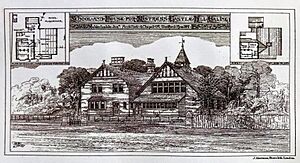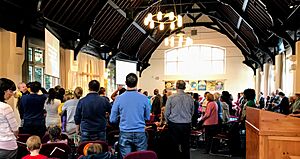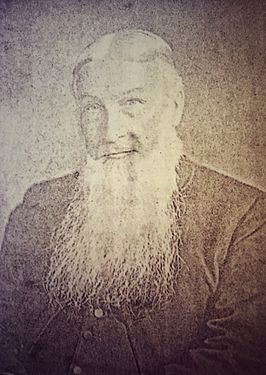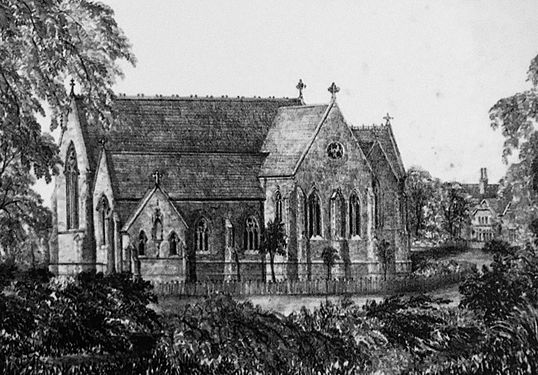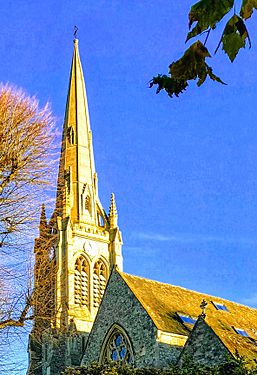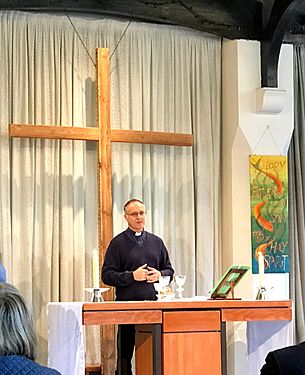St Stephen's Church, Ealing facts for kids
Quick facts for kids St Stephen's |
|
|---|---|
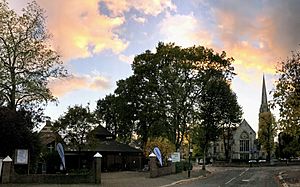
The current church (left), community centre (middle) and stone former church (right)
|
|
| 51°31′11″N 0°19′09″W / 51.5197°N 0.3193°W | |
| Location | West Ealing |
| Country | United Kingdom |
| Denomination | Church of England |
| History | |
| Founded | 1867 |
| Founder(s) | Stephen Hilliard |
| Dedication | St Stephen |
| Dedicated | 1867, 1876, 1986 |
| Architecture | |
| Architect(s) | J. Ashdown; A. Rovedino; Sir Arthur Blomfield; Ian Goldsmid |
| Style | Victorian Gothic |
| Administration | |
| Parish | St Stephen, Ealing |
| Diocese | London |
St Stephen's Church is a Church of England church located in West Ealing, London. It started in 1867 as a small Christian outreach project, called a mission. Now, it is a full parish, which means it has its own church area and community.
The very first church building was a temporary one made of iron, sometimes called a "tin tabernacle." This was replaced in 1876 by a much stronger stone building. This stone church was built in the Victorian Gothic style and is now a Grade II listed building, meaning it's protected for its history.
However, problems with the ground (called subsidence) made the stone church unsafe. It was then "deconsecrated" in 1979, which means it was no longer used as a church. Today, this old stone church has been turned into flats. It still stands out as an important building in the St Stephen's Conservation Area. The church community now meets in a newer building, which was once the church hall and was rebuilt as the third church and community centre.
Contents
The History of St Stephen's Church
The area of Ealing grew a lot after a railway station opened in 1838. Because more people moved in, a new church area, or parish, called Christ Church was created in 1853.
The vicar (a type of priest) of Christ Church, Stephen Hilliard, saw that even more people were moving to the northwest part of Ealing. So, he decided to start a new mission there. This mission would become St Stephen's.
The First Church Building
The first building for St Stephen's was a quick-to-build "iron church" made from corrugated iron. It opened on June 12, 1867. A special service was held, and the Bishop of Ripon, Robert Bickersteth, gave a sermon (a religious talk).
The Stone Church and Its Growth
The second church building was made of strong stone, costing £6,000. It was officially opened and blessed on June 3, 1876, by the Bishop of London. In 1891, a tall steeple (a pointed tower) was added, designed by Sir Arthur Blomfield.
By the early 1900s, many people attended services. In 1903, about 570 people came to morning services and 300 to evening services. In 1907, the vicar, Dr. Tupholme, started another new mission church nearby in Pitshanger. This became St Barnabas' Church, Ealing. It also started as an iron church but later got a much larger brick building. St Barnabas became its own separate parish in 1916.
The original stone church building for St Stephen's is still standing today. It is a Grade II listed building, which means it's protected. It stopped being used as a church in 1979 because of ground problems. It was then turned into flats called St Stephen's Court. The church community then moved into the church hall building, which was later rebuilt into the current church and community centre in 1987. This new building is made of modern red brick.
The Church Bells
A set of eight bells was made for the steeple by Mears & Stainbank in 1911. They were blessed in 1912. A team of bell ringers quickly started, and their regular Sunday ringing lasted about 40 minutes. Sometimes, visiting teams would ring the bells for longer. In 1921, a group called the Ancient Society of College Youths rang the bells for two hours! This caused complaints from neighbours, who found it too loud. So, it was decided that the bells would only be rung every other Sunday.
In 1979, when the old church building became unsafe, the bells were taken down. They were stored in a warehouse for a while. But in 1987, the bells were fixed up by Eayre & Smith. They were then moved to St Machar's Cathedral in Aberdeen, Scotland. This church is now one of the few in Scotland with bells set up for "change ringing," which is a special way of ringing bells in patterns.
The St Stephen's Conservation Area
The old stone church building sits on a small island at the top of a wide, straight road called The Avenue. This road is lined with large plane trees and leads up to the church in a grand way. The Avenue and North Avenue form the main part of the St Stephen's Conservation Area.
Houses in this area have special rules to keep their Edwardian look and feel. The local council says that the old church is very important to this area: "The listed former Church of St Stephen is the landmark dominating the skyline and streetscape, the focal point along all the roads in and around the CA, and visible from outside the CA. The former church not only gives its name to the CA, but also is the key point around which the area has developed and streets have been oriented. The importance of the building in the landscape was even more apparent one hundred years ago when the trees were saplings and the views down the roads were less inhibited."
The Church School
A school run by the church, called a parochial school, opened in 1867. It first used a stable building. Because it became too crowded, a new schoolroom and house were built nearby in 1882. By 1910, 209 students attended the school.
In 1911, the girls and young children moved to North Ealing School, which was run by the council. The boys also moved there in 1921. The old school buildings were then rented to the council. They stopped being used as a school in 1934 and were sold privately in 1937.
Church Services and Activities
St Stephen's Church now holds services every weekday morning. On Sundays, there is a traditional Anglican service. This service follows the Common Worship book and uses the New International Version of the Bible. After a short break for refreshments, a more relaxed service follows. This service features music in a modern style.
There is also a Sunday evening service. The church holds special services for important times in the church year, like Advent, Easter, and Christmas.
Other activities at the church include the Alpha course, a summer fair (called a fête), afternoon tea gatherings, and a "Shining Stars" group for young children and their parents.
Gallery
-
Rev. Steve Newbold celebrating communion



